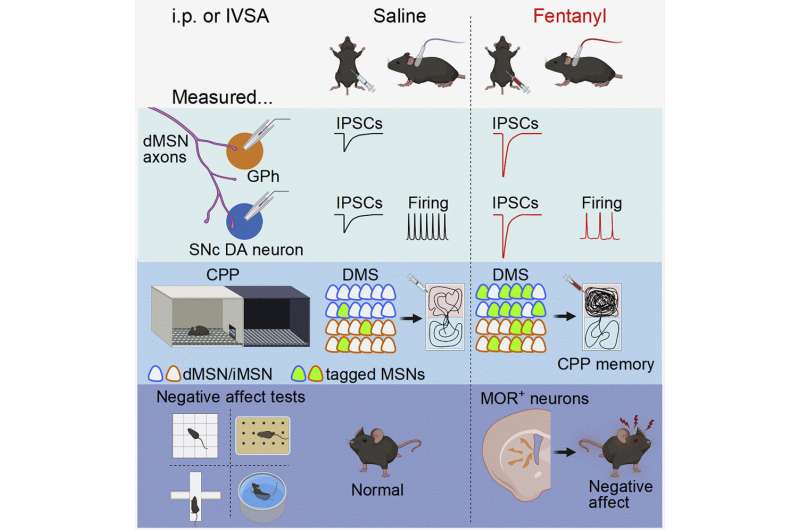This article has been reviewed according to Science X's editorial process and policies. Editors have highlighted the following attributes while ensuring the content's credibility:
fact-checked
peer-reviewed publication
trusted source
proofread
Researchers identify brain circuit involved in fentanyl abuse and relapse

The ongoing opioid epidemic continues to take a heavy toll on American communities, with more than 80,000 opioid-related deaths reported in 2021, according to the National Institutes of Health. Despite the severity of this issue, the neurological mechanisms underlying opioid addiction, withdrawal and relapse are not fully understood.
A study recently published in Cell Reports sheds light on the subject. Jun Wang, associate professor in the Department of Neuroscience and Experimental Therapeutics at the Texas A&M University School of Medicine, and members of his laboratory have identified a specific brain circuit that characterizes how fentanyl (a synthetic opioid) affects the brain. Specifically, they looked at the striatum, which is a brain region that controls voluntary behaviors and is heavily implicated in drug relapse.
Even after a long period of abstaining from opioids, many people relapse as a result of the depression, anxiety and other negative emotions that accompany withdrawal. Suppressing these negative emotional states could greatly increase a person's chance of overcoming opioid use disorder.
Opioid addiction is mainly mediated by mu-opioid receptors (MORs), which are expressed in the midbrain and the striatum on a type of neuron called direct pathway medium spiny neurons (dMSNs). Previous studies from the Wang lab showed these dMSNs control "go" actions in the brain that promote drug-seeking behaviors. The striatum contains two distinct sub-compartments, the patch and matrix compartments. The patch compartments primarily contain MOR-expressing dMSNs and are widely studied for their roles in emotional processing and decision-making.
The study aimed to look at how withdrawal from chronic opioid exposure alters the activity of patch dMSNs and their outputs to generate the negative emotional states which may cause relapse. The researchers discovered that fentanyl enhances the activity of dMSNs in the striatum, and during the early stages of withdrawal, inhibitory signals from these dMSNs to downstream targets, such as dopaminergic neurons, were significantly enhanced.
Dopaminergic neurons play a major role in addiction as they control motivation, rewarding behavior and emotions. The enhanced suppression of dopaminergic neurons likely contributes to the negative emotions that arise during acute fentanyl withdrawal, as the researchers found that inhibiting these dMSNs can reduce withdrawal symptoms and anxiety-like behaviors.
The findings of this research provide new insights into the mechanism underlying opioid-induced negative emotional states, and pave the way for potential treatments for opioid use disorders. By reducing the negative emotional states that accompany withdrawal, it may be possible to reduce the risk of relapse and decrease the number of lives lost to opioids.
In summary, the study provides new understanding of the brain circuits involved in opioid addiction and withdrawal and could lead to the development of new treatment for opioid use disorders.
More information: Wei Wang et al, Striatal μ-opioid receptor activation triggers direct-pathway GABAergic plasticity and induces negative affect, Cell Reports (2023). DOI: 10.1016/j.celrep.2023.112089
















